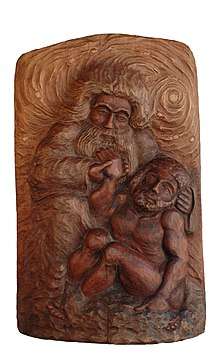Creation of life from clay
The "creation of life from clay" is a miraculous birth theme and scientific study that appears in mythology, literature, and modern theory.

"Creation of Adam" a bas-relief in wood by Tadeusz Kowalski.
Religion and folklore
- In Greek mythology, according to Pseudo-Apollodorus,[1] Prometheus molded men out of water and earth.
- In Sumerian mythology, the gods Enki or Enlil create a servant of the gods, humankind, out of clay and blood (see Enki and the Making of Man). In another Sumerian story, both Enki and Ninmah create humans from the clay of the Abzu, the fresh water of the underground. They take turns in creating and decreeing the fate of the humans.[2]
- In the Epic of Gilgamesh, Enkidu is created by the goddess Aruru out of clay to be a partner for Gilgamesh, "mighty in strength".
- According to Egyptian mythology, the god Khnum creates human children from clay before placing them into their mother's womb.[3]
- According to Chinese mythology, (see Chu Ci and Imperial Readings of the Taiping Era), Nüwa molded figures from the yellow earth, giving them life and the ability to bear children.
- In the Babylonian creation epic Enuma Elish, the goddess Ninhursag created humans from clay.
- According to Hindu mythology, the mother of Ganesh — Parvati — made Ganesh from clay and turned the clay into flesh and blood.
- According to some Laotian folk religion, there are stories of humans created from mud or clay.
- In Hawaiian tradition, the first man was composed of muddy water and his female counterpart was taken from his side parts.[4]
- According to Genesis 2:7 "And the Lord God formed man of the dust of the ground, and breathed into his nostrils the breath of life; and man became a living soul".
- In Jewish folklore, a golem (Hebrew: גולם) is an animated anthropomorphic being that is created entirely from inanimate matter usually clay or mud.
- The Māori people believe that Tāne Mahuta, god of the forest, created the first woman out of clay and breathed life into her.
- According to Inca mythology the creator god Viracocha formed humans from clay on his second attempt at creating living creatures.
- In Norse culture humans are made from sand in tree trunks.[5]
- In the Korean Seng-gut narrative, humans are created from red clay.
- According to the beliefs of some Indigenous Americans, the Earth-maker formed the figure of many men and women, which he dried in the sun and into which he breathed life.[6]
Scientific theory
- The role of clay minerals in the origin of life was suggested scientifically in a 2013 paper titled Developments in Clay Science.[7]
Further reading
- Bellows, Henry Adams (Trans.) (1936). The Poetic Edda. Princeton University Press. New York: The American-Scandinavian Foundation.
- Byock, Jesse (Trans.) (2006). The Prose Edda. Penguin Classics. ISBN 0-14-044755-5
- Davidson, H. R. Ellis (1975). Scandinavian Mythology. Paul Hamlyn. ISBN 0-600-03637-5
- Dronke, Ursula (Trans.) (1997). The Poetic Edda: Volume II: Mythological Poems. Oxford University Press. ISBN 0-19-811181-9
- Larrington, Carolyne (Trans.) (1999). The Poetic Edda. Oxford World's Classics. ISBN 0-19-283946-2
- Lindow, John (2001). Norse Mythology: A Guide to the Gods, Heroes, Rituals, and Beliefs. Oxford University Press. ISBN 0-19-515382-0
- Orchard, Andy (1997). Dictionary of Norse Myth and Legend. Cassell. ISBN 0-304-34520-2
- Puhvel, Jaan (1989 [1987]). Comparative Mythology. Johns Hopkins University Press. ISBN 0-8018-3938-6
- Schach, Paul (1985). "Some Thoughts on Völuspá" as collected in Glendinning, R. J. Bessason, Heraldur (Editors). Edda: a Collection of Essays. University of Manitoba Press. ISBN 0-88755-616-7
- Simek, Rudolf (2007) translated by Angela Hall. Dictionary of Northern Mythology. D.S. Brewer. ISBN 0-85991-513-1
- Thorpe, Benjamin (Trans.) (1907). The Elder Edda of Saemund Sigfusson. Norrœna Society.
- Thorpe, Benjamin (Trans.) (1866). Edda Sæmundar Hinns Frôða: The Edda of Sæmund the Learned. Part I. London: Trübner & Co.
gollark: Yep.
gollark: If you mean rooms, not homeservers.
gollark: 10000 people or so on a few.
gollark: Matrix is a protocol with various FOSS implementations.
gollark: Discord is a proprietary platform.
References
- Bibliotheca 1.7.1
- The Electronic Text Corpus of Sumerian Literature
- Encyclopedia Britannica
- Abraham Fornander; Thomas Thrum (1920). Fornander Collection of Hawaiian Antiquities and Folk-lore. Bishop Museum Press. p. 335.
- Hultgård, Anders (2006). "The Askr and Embla Myth in a Comparative Perspective". In Andrén, Anders; Jennbert, Kristina; Raudvere, Catharina (editors).Old Norse Religion in Long-term Perspectives. Nordic Academic Press. ISBN 91-89116-81-X
- Almost Ancestors: The First Californians by Theodora Kroeber and Robert F. Heizer
- Brack, A. (2013-01-01), Bergaya, Faïza; Lagaly, Gerhard (eds.), "Chapter 10.4 - Clay Minerals and the Origin of Life", Developments in Clay Science, Handbook of Clay Science, Elsevier, 5, pp. 507–521, retrieved 2019-08-19
This article is issued from Wikipedia. The text is licensed under Creative Commons - Attribution - Sharealike. Additional terms may apply for the media files.